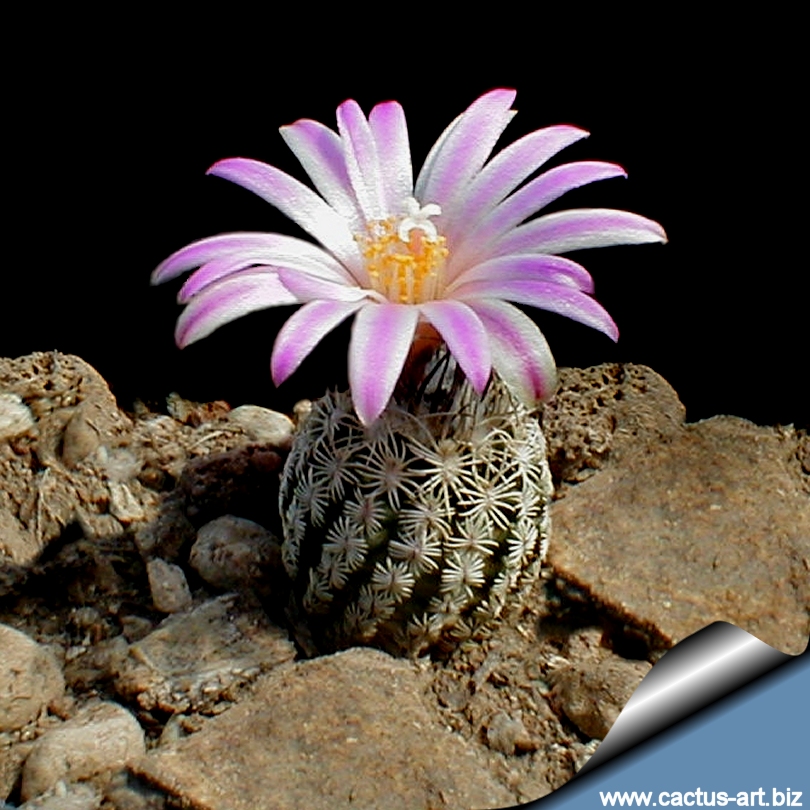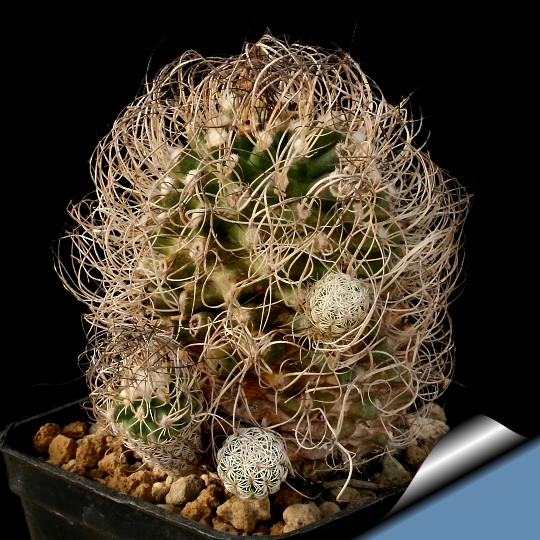|
|
|

A young plant with juvenile spines which are radiating and pectinated,
2-4 mm long and completely different from the spines of adult specimens.
|
|
T. pseudomacrochele ssp.
Lausseri is a desirable Mexican plants with nice pinkish-purple striped
petals.
Etymology: Named for the Laussers, a German couple who explored
and collected cactus in northern New Mexico
Description: Mostly solitary, but occasionally the root
bears several stems. Body flattened globular cylindrical, 20-40mm
high 25-35mm wide dark green. Ribs spiralling, divided into low
and rounded conical tubercles3-5mm long. Areoles in new growth
with white wool,
Root: up to 8 cm long taproot.
Spines: Only radials- 3-12 yellowish-brown becoming greyish
mostly erect bristly and twisted 15-30mm long. Juvenile spines at the
base of the stem ±radiating and pectinated, 2-4 mm long.
Flowers: from the areoles at the apex Reddish-purple 25mm
long, 25mm wide.
Fruits: The fruit is green almost round 4-6mm diameter and bears
the dried remnants of the flower. It opens with a vertical slit when
ripe.
Note: This taxa is closely related (or identical) with T.
pseudomacrochele var. sphacellatus and very similar to
Turbinicarpus krainzianus too.
|
|
Photo of conspecific taxa, varieties, forms and cultivars of
Turbinicarpus pseudomacrochele:
Advertising
|
|
|
|
|
Scientific name: Turbinicarpus
pseudomacrochele ssp. lausseri (Diers & G.Frank) C.E.Glass
Conservation status: Listed in
CITES appendix I
Locality: First discovered
in 1986 growing on the steep rocky slopes of the Sierra del Doctor,
Querétaro and Hidalgo, México.
Synonym:
-
Turbinicarpus lausseri
-
Turbinicarpus pseudomacrochele
var. lausseri Diers & G. Frank
-
Turbinicarpus pseudomacrochele
ssp. krainzianus fa. Lausseri
-
Pediocactus pseudomacrochele
ssp lausseri
-
Turbinicarpus pseudomacrochele
-
Kadenicarpus pseudomacrochele
var. lausseri
-
Neolloydia pseudomacrochele v.
lausseri

Rare in cultivation it is
slow growing with black and grey weak papery
spines that curl around the top of the plant.
|
|
|
|
Cultivation: This species is fairly robust and easy to grow.
Watering should be rather infrequent to keep plant compact. The fact
that the plant retracts into the soil and assume a grey-green colouring
between watering, is perfectly natural and doesn’t cause any damage.
Hardy to -4°C for a short period. Exposures: Full sun where it obtains a
flat natural looking or part sun.

 |
|